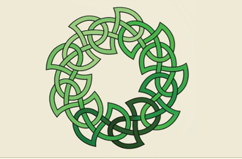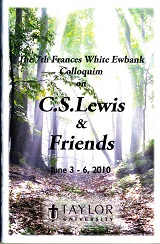Event Title
Session 1-B
Location
Taylor University, Metcalf 104
Start Date
3-6-2010 3:45 PM
Description
"Creation and Sub-creation in Leaf by Niggle" - J. Samuel Hammond and Marie K. Hammond
In his essay On Fairy Stories and his poem Mythopoeia, J.R.R. Tolkien describes the concept of sub-creation. The story Leaf by Niggle, published as a companion and complement to the essay, illustrates this concept and shows how it relates to Creation. In particular, the story presents Tolkien’s ideas about art, employment, and responsibility toward neighbors. It paints a perceptive portrait of the author himself. Moreover, it offers inspiration for artists, writers, scholars, and all who engage in constructive labor, and gives guidance to those who (like the author) feel the pressure of too much work. Perhaps most importantly, this fascinating tale conveys to the reader Truth inherent in Creation.
"Old MacDonald Had a Farm: An Exploration of Animal Literature and its Subtext through the Theology of George MacDonald" - Laura Stanifer
Tales all the way from Grimms’ The Frog Princess to C.S. Lewis’ Chronicles of Narnia all tell us that there is more subtext to animals in literature than we realize. They can represent the meaning of family, as in the werewolves in Stephenie Meyer’s Twilight series, or the character of our soul, as in the Harry Potter series. I will touch on each of these elements while centering on George MacDonald’s view of animals as representing one of God’s miracles, amazingly similar to humans in their feeble nature and yet just as capable of being redeemed in the end. Matthew 15:27 says, “Even the dogs eat the crumbs that fall from their masters’ table.” MacDonald, taking this verse to heart, shows us the extent of God’s love and mercy for every one of his creation.
Moderator: Linda Lambert
Event Type
Paper
Session 1-B
Taylor University, Metcalf 104
"Creation and Sub-creation in Leaf by Niggle" - J. Samuel Hammond and Marie K. Hammond
In his essay On Fairy Stories and his poem Mythopoeia, J.R.R. Tolkien describes the concept of sub-creation. The story Leaf by Niggle, published as a companion and complement to the essay, illustrates this concept and shows how it relates to Creation. In particular, the story presents Tolkien’s ideas about art, employment, and responsibility toward neighbors. It paints a perceptive portrait of the author himself. Moreover, it offers inspiration for artists, writers, scholars, and all who engage in constructive labor, and gives guidance to those who (like the author) feel the pressure of too much work. Perhaps most importantly, this fascinating tale conveys to the reader Truth inherent in Creation.
"Old MacDonald Had a Farm: An Exploration of Animal Literature and its Subtext through the Theology of George MacDonald" - Laura Stanifer
Tales all the way from Grimms’ The Frog Princess to C.S. Lewis’ Chronicles of Narnia all tell us that there is more subtext to animals in literature than we realize. They can represent the meaning of family, as in the werewolves in Stephenie Meyer’s Twilight series, or the character of our soul, as in the Harry Potter series. I will touch on each of these elements while centering on George MacDonald’s view of animals as representing one of God’s miracles, amazingly similar to humans in their feeble nature and yet just as capable of being redeemed in the end. Matthew 15:27 says, “Even the dogs eat the crumbs that fall from their masters’ table.” MacDonald, taking this verse to heart, shows us the extent of God’s love and mercy for every one of his creation.
Moderator: Linda Lambert


